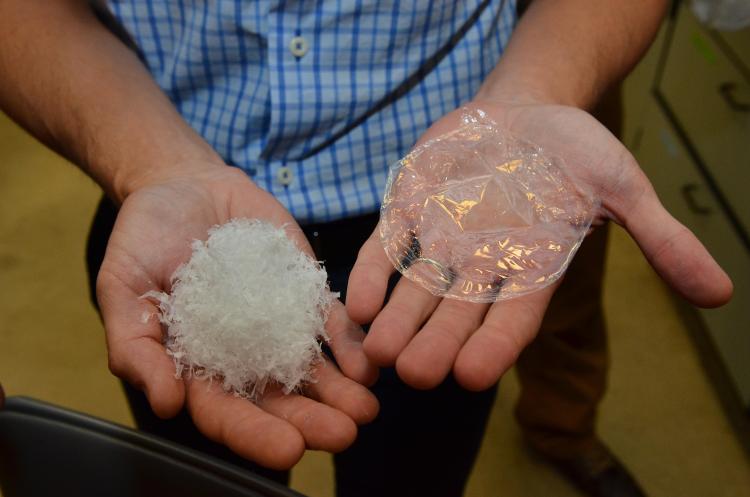Partnership 'looks into' creating new material from eyeglass lens waste
When serial entrepreneur and Boulder resident Bart Foster is successful with a startup of his, he makes sure others win. It’s part of his philosophy.
“It just makes sense,” says Foster, who years ago was hugely successful, raising over $50 million in capital for one startup – self-service biometric health kiosks found in grocery stores and other retail locations. “If you’re wildly successful, if the thing you’re working on goes nuts (in a good way), the people who helped you early on should win.”
There are a handful of people at CU Boulder – faculty, staff and students – who will win if Foster triumphs with his current quandary. In fact, they might say they’re already benefiting from the project. Together, they’re figuring out how to recycle the swarf, or shavings, produced in the making of eyeglass lenses. Several tons of the stuff is dumped into landfills each year.
Foster, who has more than 15 years of experience in the optical industry, began pondering the problem after perusing a Denver shop that sells nothing but reclaimed or repurposed furniture and accessories.
“That store was one of my inspirations,” says Foster. “As I walked through, I asked myself, ‘What else is in abundance and going into landfills, but could be recycled?’ And then I made a list of a hundred items.”
Most lenses are made out of a synthetic material, not glass. Initially about the size of a hockey puck that’s filed down to shape by machinery, a lens’s swarf looks like fake snow – the type you might see in a wintertime storefront display.

But it’s a challenging material to recycle, a code no one has yet cracked. The substance is comprised by three or more types of plastic that each respond differently to heat, so it can’t simply be melted down. The byproduct also can contain coolant and metals and is moist, so an efficient cleaning and drying process needs to be devised if it’s going to be reused.
If certain unwanted parts of the material could be removed and other substances could be added at the molecular level, perhaps a new material could be created,” says Foster. “Perhaps we could turn the swarf into building materials, outdoor clothing and gear, or safety equipment, like helmets.
However, to analyze the material and explore its possibilities, as well as plan and prepare for commercialization, should the project succeed, Foster needed technical guidance and research prowess.
Enter CU Boulder. Foster reached out, seeking cross-campus expertise to advance his idea. One ongoing resource for him is the Office of Industry Collaboration, which supports partnerships between the university and outside entrepreneurs, as well as business and industry organizations.
“He saw an industry problem, had some thoughts on possible solutions and needed support to determine if the problem could be solved,” said Caroline Himes, director of the office. “He also had a track record of success in taking new ideas to market, had high-level connections in the industry and probable access to funding.”
The Office of Industry Collaboration facilitated introducing Foster to Wil Srubar, assistant professor of civil, environmental and architectural engineering, and Wei Zhang, associate professor of chemistry and biochemistry. And a research project was born.
“Our preliminary results have been extremely promising,” says Srubar. “Our team here at CU Boulder has discovered critical reprocessing pathways that allow for the material to be recovered and re-engineered for future uses.
“Industry-university partnerships offer much value to companies,” adds Srubar. “Bart had to invest little in startup costs related to equipment and expertise, instead leveraging the world-class resources we have here. My research team has been able to identify novel technologies that, in turn, are patentable and licensable, and we are able to share our knowledge with the broader scientific community through patents and publications.”
Foster also connected with the Technology Transfer Office, which – on behalf of both Foster and CU Boulder – will help secure intellectual property rights and set the course for any licensing options to come out of the project. Additionally, he linked with and was advised by a CU Boulder law student and five MBA students.
But Foster hasn’t been on the receiving-end-only of this partnership. During the process, he’s focused on building capital, securing over $250,000 from a number of major organizations in the optical industry. He also became a mentor to CU Boulder’s entrepreneurial community through the annual New Venture Challenge.
“It is an ideal combination of connecting an experienced entrepreneur with CU Boulder skills and talent,” says Himes.
The environment and optical companies, which are seeking sustainable options, according to Foster, benefit from any advances as well.
“I see this as the formula, pulling together a whole team of people who can help create a business where everyone wins,” says Foster. “So I’m hopeful to do it again, multiple times. It’s what I like to do.”
It’s also what CU Boulder likes to do.
---
Photo: Bart Foster (front-left) and Wil Srubar (front-right) look through a pair of eyeglass lenses with graduate research assistants Sankar Ravichandran (back-left) and Elizabeth Delesky (back-right) standing behind them. (Photo by Casey A. Cass/University of Colorado Boulder)


